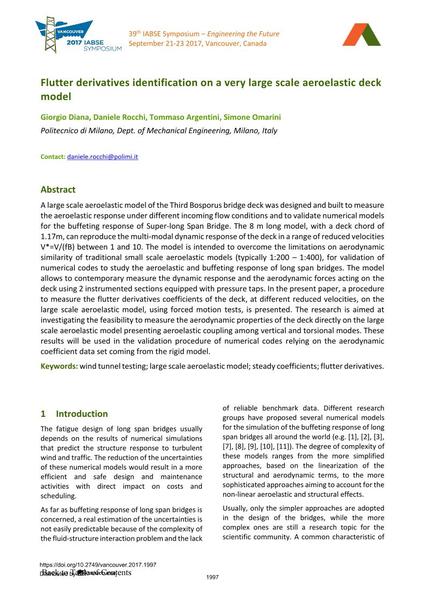Flutter derivatives identification on a very large scale aeroelastic deck model

|
|
|||||||||||
Bibliographic Details
| Author(s): |
Giorgio Diana
Daniele Rocchi (Politecnico di Milano, Dept. of Mechanical Engineering, Milano, Italy) Tommaso Argentini Simone Omarini (Politecnico di Milano, Dept. of Mechanical Engineering, Milano, Italy) |
||||
|---|---|---|---|---|---|
| Medium: | conference paper | ||||
| Language(s): | English | ||||
| Conference: | IABSE Symposium: Engineering the Future, Vancouver, Canada, 21-23 September 2017 | ||||
| Published in: | IABSE Symposium Vancouver 2017 | ||||
|
|||||
| Page(s): | 1997-2005 | ||||
| Total no. of pages: | 9 | ||||
| Year: | 2017 | ||||
| DOI: | 10.2749/vancouver.2017.1997 | ||||
| Abstract: |
A large scale aeroelastic model of the Third Bosporus bridge deck was designed and built to measure the aeroelastic response under different incoming flow conditions and to validate numerical models for the buffeting response of Super-long Span Bridge. The 8 m long model, with a deck chord of 1.17m, can reproduce the multi-modal dynamic response of the deck in a range of reduced velocities V*=V/(fB) between 1 and 10. The model is intended to overcome the limitations on aerodynamic similarity of traditional small scale aeroelastic models (typically 1:200 – 1:400), for validation of numerical codes to study the aeroelastic and buffeting response of long span bridges. The model allows to contemporary measure the dynamic response and the aerodynamic forces acting on the deck using 2 instrumented sections equipped with pressure taps. In the present paper, a procedure to measure the flutter derivatives coefficients of the deck, at different reduced velocities, on the large scale aeroelastic model, using forced motion tests, is presented. The research is aimed at investigating the feasibility to measure the aerodynamic properties of the deck directly on the large scale aeroelastic model presenting aeroelastic coupling among vertical and torsional modes. These results will be used in the validation procedure of numerical codes relying on the aerodynamic coefficient data set coming from the rigid model. |
||||
| Keywords: |
wind tunnel testing flutter derivatives large scale aeroelastic model steady coefficients
|
||||
